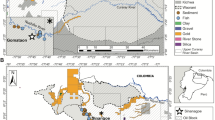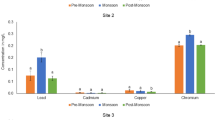Abstract
Cadmium (Cd) and lead (Pb) were determined in three species of mollusks and associated sediment. Samples were collected from two locations along the intertidal zone of the Persian Gulf near Bandar Abbas. The study was conducted during the spring of 2011, 10 sediment samples and 15 mollusks from each of the following species: Saccostrea cucullata, Solen brevis, and Callista umbonella, were simultaneously collected. Soft tissue, shell, and sediment were tested for metals using an atomic absorption spectrophotometer. Geochemical fractions of the sediment were examined for metals using a sequential extraction technique. Our results indicate that over half of Cd and Pb in the sediment had natural origins. Independent sample t test showed statistically significant (p < 0.05) inter-tissue differences in accumulation of Cd and Pb. Soft tissue of C. umbonella contained highest levels of Cd. Pb accumulation was highest in S. brevis shell. Significant correlations (p < 0.05) were found between Cd in the soft tissue of C. umbonella and its levels in the geochemical fractions of the sediment. Lead levels in the resistant geochemical fractions of the sediment and S. brevis shell were significantly correlated. Our results suggest that soft tissue of C. umbonella and shell of S. brevis are reliable biomonitoring tools for Cd and Pb, respectively.



Similar content being viewed by others
References
Abu-Kukati, Y., et al. (2001). Heavy metals distribution and speciation in sediments from Ziqlab Dam-Jordan. Jeafaß Mühendisliği, 25(1), 33–40.
Apeti, D. A., Robinson, L., Johnson, E., et al. (2005). Relationships between heavy metal concentrations in the American oyster (Crassostrea virginica) and metal levels in the water column and sediment in Apalachicola Bay, Florida. Journal of Environmental Sciences, 1(3), 179–186.
Azarbad, H., Khoi, A. J., Mirvaghefi, A., Danekar, A., Shapoori, M., et al. (2010). Biosorption and bioaccumulation of heavy metals by rock oyster Saccostrea cucullata in the Persian Gulf. International Aquatic Research, 2, 61–69.
Badri, M. A., Aston, S. R., et al. (1983). Observation on heavy metal geochemical associations in polluted and nonpolluted estuarine sediments. Environment Pollution B Chemistry and Physics, 6(3), 181–193.
Basaham, A. S. (2010). Distribution and partitioning of heavy metals in subtidal sediments of the Arabian Gulf coast of Saudi Arabia. JKAU: Earth Science, 21(1), 201–222.
Blinda, M., Sabhi, Y., Quessar, S. E., Fekhaouim, M., Brahim, L. A., et al. (2005). Dynamics of heavy-metal transfer between biotic (Cytheria chione and Cerastoderma edule) and abiotic (water and sediment) components in marine environment (Bay of Martil, Moroccan Mediterranean coast). Chemistry and Ecology, 21(4), 279–301.
Einollahi Peer, F., Safahieh, A., Dadollahi Sohrab, A., Pakzad Tochaii, S. et al. (2010). Heavy metal concentrations in rock oyster Saccostrea cucullata from Iranian coasts or the Oman Sea. Trakia Journal of Sciences, 8(1), 79–86.
Griscom, S. H., Fisher, N. S., et al. (2004). Bioavailability of sediment-bound metals to marine bivalve molluscs: An overview. Estuaries and Coasts, 7(5), 826–838.
Gupta, S. K., Singh, J., et al. (2011). Evaluation of mollusce as sensitive indicator of heavy metal pollution in aquatic system: areview. IIOAB Journal, 2(1), 49–57.
Haidari Chaharlang, B., Riyahi Bakhtiari, A., Yavari, V., et al. (2012). Assessment of cadmium, copper, lead and zinc contamination using oysters (Saccostrea cucullata) as biomonitors on the coast of the Persian Gulf. Iran. Bulletin Environment Contamination Toxicology, 88, 956–961.
Hamed, M. A., Emara, A. M., et al. (2006). Marine molluscs as biomonitors for heavy metal levels in the Gulf of Suez, Red Sea. Journal of Marine Systems, 60, 220–234.
Hayes, W. J., Anderson, I. J., Gaffoor, M. Z., Hurtado, J., et al. (1998). Trace metals in oysters and sediments of Botany Bay Sydney. Science Total Environment, 212, 39–47.
Hosseinzadeh Sahafi, H., Daghoghi, B., Rameshi, H., et al. (2000). Atlas of the Persian Gulf mollusks. Iran: Tehran.
Izquierdo, C., Usero, J., Gracia, I., et al. (1997). Speciation of heavy metals in sediments from salt marshes on the southern Atlantic coast of Spain. Marine Pollution Bulletin, 34(2), 123–128.
Kamaruzzaman, B. Y., Zahir, M. S., Akbar John, B., Siti Waznah, A., Jalal, K. C. A., Shahbudin, S., et al. (2010). Determination of some heavy metal concentrations in Rozar clam (Solen brevis) from Tanjong Lumpur coastal Waters, Pahang, Malaysia. Pakistan Journal of biological sciences, 13(24), 1208–1213.
Kanakaraju, D., Jios, C., Long, S. M., et al. (2008a). Heavy metal concentrations in the rozar clams (Solen spp) from Muara tebas, Sarawak. The Malaysian Journal of Analytical Sciences, 12(1), 53–58.
Kanakaraju, D., Ibrahim, F., Berseli, M. N., et al. (2008b). Comparative study of heavy metal concentrations in razor clam (Solen regularis) in Moyan and Serpan, Sarawak. Global Journal Environment Research, 2(2), 87–91.
Karbassi, A. R., Nabi-Bidhendi, G. R., Bayati, I., et al. (2005). Environmental geochemistry of heavy metals in a sediment core off Busher, Persian Gulf. Iran Journal of Environment Health Science Engineering, 2(4), 255–260.
Karbassi, A. R., Monavari, S. M., Nabi Bidhendi, G. R., Nouri, J., Nematpour, K., et al. (2008). Metal pollution assessment of sediment and water in the Shur River. Environmental Monitoring and Assessment, 147, 107–116.
Kazemi, A., Riyahi Bakhtiari, A., Mohammad Karami, A., Haidari, B., Kheirabadi, N., et al. (2013). Bioavailability and variability of Cd, Pb, Zn, and Cu pollution in soft tissues and shell of Saccostrea cucullata collected from the coast of Qeshm Island, Persian Gulf, Iran. Iranian journal of toxicology, 7(21), 836–841.
Liang, L. N., He, B., Jiang, G. B., Chen, D. Y., Yao, Z. W., et al. (2004). Evaluation of mollusks as biomonitors to investigate heavy metal contaminations along the Chinese Bohai Sea. Science of the Total Environment, 324, 105–113.
Liu, W., Deng, P. Y., et al. (2007). Accumulation of cadmium, copper, lead and zinc in the pacific oyster, Crassostrea gigas, collected from the Pearl River estuary, southern China. Bulletin of Environmental Contamination and Toxicology, 78, 535–538.
Maanan, M. (2008). Heavy metal concentrations in marine molluscs from the Moroccan coastal region. Environmental Pollution, 153, 176–183.
Mo, C., & Neilson, B. (1994). Standardization of oyster soft dry weight measurements. Water Research, 28(1), 243–246.
Paul, S. K. (2001). Geochemistry of bottom sediments from a river-estuary-shelf mixing zone on the tropical southwest coast of India. Bulletin of the Geological Survey of Japan, 52(8), 371–382.
Peer, F. E., Safahieh, A., Sohrab, A. D., Tochaii, S. P., et al. (2010). Heavy metal concentrations in rock oyster Saccostrea cucullata from Iranian coasts of the Oman Sea. Trakia Journal Science, 8, 79–86.
Pempkowiak, J., Sikora, A., Biernacka, E., et al. (1999). Speciation of heavy metals in marine sediments vs their bioaccumulation by mussels. Chemosphere, 39(2), 313–321.
Rojas de Astudillo, L., Chang Yen, I., Agard, J., Bekele, I., Hubbard, R., et al. (2002). Heavy metals in green mussel (Perna viridis) and Oysters (Crassostrea sp.) from Trinidad and Venezuela. Archives of Environmental Contamination and Toxicology, 42, 410–415.
Salahshur, S., Riyahi Bakhtiari, A., Preeta, K., et al. (2012). Use of Solen brevis as a biomonitor for Cd, Pb and Zn on the intertidal zones of Bushehr-Persian Gulf, Iran. Bulletin Environment Contamination Toxicology, 88(6), 951–955.
Shirneshan, G., & Riyahi Bakhtiari, A. (2012). Accumulation and distribution of Cd, Cu, Pb and Zn in the soft tissue and shell of oysters collected from the northern coast of Qeshm Island, Persian Gulf, Iran. Chemical Speciation and Bioavailability, 24(3), 1–10.
Shulkin, V. M., Presley, B. J., Kavun, V. I., et al. (2003). Metal concentrations in mussel Crenomytilus grayanus and oyster Crassostrea gigas in relation to contamination of ambient sediments. Environment International, 29, 493–502.
Tanner, P., Leong, L. S., Pan, S. M., et al. (2000). Contamination of heavy metals in marine sediment cores from Victoria Harbour Hong Kong. Marine Pollution Bulletin, 40, 769–779.
Va’zquez-Sauceda, M., Aguirre-Guzma’n, G., Sa’nchez-Martı’nez, J., Pe’rez-Castan˜ eda, R., et al. (2011). Cadmium, Lead and zinc concentrations in water, sediment and oyster (Crassostrea virginica) of San Andres Lagoon Mexico. Bulletin of Environmental Contamination and Toxicology, 86(4), 410–414.
Wang, S., Jia, Y., Wang, S., Wang, X., Wang, H., Zhao, Z., et al. (2010). Fractioation of heavy metals in shallow marine sediments from Jinzhou Bay, China. Journal of Environmental Sciences, 22(1), 23–31.
Yap, C. K., & Cheng, W. H. (2008). Heavy metal concentrations in Nerita lineata: the potential as a biomonitor for heavy metal bioavailability and contamination in the tropical intertidal area. Marine Biodiversity Records, 2, 1–8.
Yap, C. K., Ismail, A., Tan, S. G., Omar, H., et al. (2002). Correlations between speciation of Cd, Cu Pb and Zn in sediment and their concentrations in total soft tissue of green-lipped mussel Perna viridis from the west coast of Peninsular Malaysia. Environment International, 28, 117–126.
Yap, C. K., Ismail, A., Tan, S. G., Abdul Rahim, I., et al. (2003). Can the shell of the green-lipped mussel Perna viridis from the west coast of Peninsular Malaysia be a potential biomonitoring material for Cd, Pb and Zn? Estuarine, Coastal and Shelf Science, 57, 623–630.
Yap, C. K., Ismail, A., Cheng, W. H., Tan, S. G., et al. (2006). Crystalline style and tissue redistribution in Perna viridis as indicators of Cu and Pb bioavailabilities and contamination in coastal waters. Ecotoxicology and Environmental Safety, 63, 413–423.
Yesudhason, P., Al-Busaidi, M., Al-Rahbi, W. A. K., Al-Waili, S. A., Al-Nakhaili, K. A., Al-Mazrooei, N. A., et al. (2013). Distribution patterns of toxic metals in the marine oyster Saccostrea cucullata from the Arabian Sea in Oman: spatial, temporal, and size variations. Springer Plus, 2(282), 1–9.
Yu, K. C., Tsai, L. J., Chen, S. H., Ho, S. T., et al. (2001). Correlation analyses on binding behavior of heavy metals with sediment matrices. Water Research, 35(10), 2417–2428.
Acknowledgments
We are grateful to Mr. Bagheri of the Iranian National Institute of Oceanography (INIO) for his critical evaluation of this manuscript, and we thank Mrs. Afshar and Haghdoost for their laboratory assistance. Funding for this research was provided by Tarbiat Modares University.
Author information
Authors and Affiliations
Corresponding author
Rights and permissions
About this article
Cite this article
Bagheri, Z., Bakhtiari, A.R. & Savabieasfahani, M. Strong correlations between metal in mollusk soft tissue and nonresistant sediment fraction: a tool for biomonitoring intertidal zone of the Persian Gulf, Iran. Environ Monit Assess 186, 1977–1986 (2014). https://doi.org/10.1007/s10661-013-3511-x
Received:
Accepted:
Published:
Issue Date:
DOI: https://doi.org/10.1007/s10661-013-3511-x




